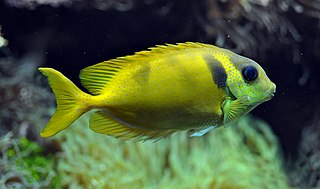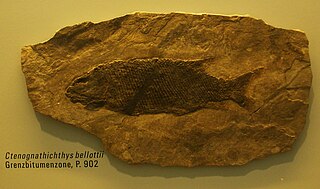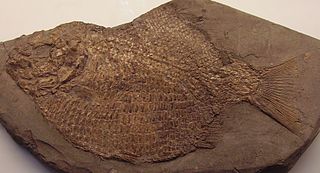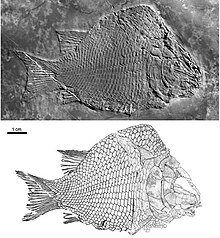
Actinopterygii, members of which are known as ray-finned fish or actinopterygians, is a class of bony fish that comprise over 50% of living vertebrate species. They are so called because of their lightly built fins made of webbings of skin supported by radially extended thin bony spines called lepidotrichia, as opposed to the bulkier, fleshy lobed fins of the sister class Sarcopterygii. Resembling folding fans, the actinopterygian fins can easily change shape and wetted area, providing superior thrust-to-weight ratios per movement compared to sarcopterygian and chondrichthyian fins. The fin rays attach directly to the proximal or basal skeletal elements, the radials, which represent the articulation between these fins and the internal skeleton.

Gars are an ancient group of ray-finned fish in the family Lepisosteidae. They comprise seven living species of fish in two genera that inhabit fresh, brackish, and occasionally marine waters of eastern North America, Central America and Cuba in the Caribbean, though extinct members of the family were more widespread. They are the only surviving members of the Ginglymodi, a clade of fish which first appeared during the Triassic, over 240 million years ago, and are one of only two surviving groups of holosteian fish, alongside the bowfins, which have a similar distribution.

Neopterygii is a subclass of ray-finned fish (Actinopterygii). Neopterygii includes the Holostei and the Teleostei, of which the latter comprise the vast majority of extant fishes, and over half of all living vertebrate species. While living holosteans include only freshwater taxa, teleosts are diverse in both freshwater and marine environments. Many new species of teleosts are scientifically described each year.

Perleidus is an extinct genus of ray-finned fish from the Triassic period. Fossils have been found in the Middle Triassic of Italy, Switzerland, and China. The inclusion of Early Triassic species in the genus Perleidus was questioned.

Holostei is a group of ray-finned bony fish. It is divided into two major clades, the Halecomorphi, represented by the single living genus, Amia with two species, the bowfins, as well as the Ginglymodi, the sole living representatives being the gars (Lepisosteidae), represented by seven living species in two genera. The earliest members of the clade, which are putative "semionotiforms" such as Acentrophorus and Archaeolepidotus, are known from the Middle to Late Permian and are among the earliest known neopterygians.

Birgeria is a genus of carnivorous marine ray-finned fish from the Triassic period. Birgeria had a global distribution, with fossil known from Madagascar, Spitsbergen, Germany, Switzerland, Italy, Slovenia, China, Russia, Canada and Nevada, United States. The oldest fossils are from Griesbachian aged beds of the Wordie Creek Formation of East Greenland. Birgeria existed throughout the entire Triassic period, from the very beginning just after the Permian-Triassic mass extinction, up to the very end with its extinction during the Triassic-Jurassic mass extinction.

Pteronisculus is an extinct genus of prehistoric ray-finned fish that lived during the Early Triassic and Middle Triassic epochs of the Triassic period worldwide.

Ctenognathichthys is an extinct genus of prehistoric bony fish that lived during the Anisian and Ladinian ages of the Middle Triassic epoch in what is now southern/southeastern Switzerland and northern Italy.

Allolepidotus is an extinct genus of prehistoric marine neopterygian ray-finned fish from the Middle Triassic epoch of what is now Italy, Spain, and Switzerland. It was formerly referred to the halecomorph order Panxianichthyiformes, but is now thought to be a member of the Ionoscopiformes.

Macrosemiidae is an extinct family of ginglymodian fish. The family first appeared during the Middle Triassic and disappeared during the Late Cretaceous. The group has been found in rock formations in Africa, Australia, Eurasia and North America. As ginglymodians, their closest living relatives are gars, with them being typically placed as nested within the Semionotiformes. Many members of the family have elongated dorsal fins, often associated with adjacent area of skin which was free of scales. These fins were likely undulated for use in precision swimming. Their body morphology suggests that they were slow swimmers that were capable of maneuvering around complex topography, such as reef environments.

Sinosaurosphargis is an extinct genus of basal marine saurosphargid reptile known from the Middle Triassic Guanling Formation of Yunnan and Guizhou Provinces, southwestern China. It contains a single species, Sinosaurosphargis yunguiensis.

Luoxiongichthys is an extinct genus of basal actinopterygian known from the lower Middle Triassic of Luoxiong Town, Luoping County of Yunnan Province, southwestern China.

Potanichthys is a fossil genus of thoracopterid fish found in deposits from China dating to the Ladinian age of the Middle Triassic epoch. It contains only one species, Potanichthys xingyiensis. It is known to have been the first vertebrate ever to have glided over water, and thus the first fish ever that had over-water gliding strategy. The genus name Potanichthys is a portmanteau of the Ancient Greek ποτάνος and ιχθύς. The species epithet refers to Xingyi city which is near the site where Potanichthys was discovered.

Halecomorphi is a taxon of ray-finned bony fish in the clade Neopterygii. The only extant Halecomorph species are the bowfin and eyespot bowfin, but the group contains many extinct species in several families in the order Amiiformes, as well as the extinct orders Ionoscopiformes, Panxianichthyiformes, and Parasemionotiformes. The fossil record of halecomorphs goes back at least to the Early Triassic epoch.

Ginglymodi is a clade of ray-finned fish containing modern-day gars (Lepisosteidae) & their extinct relatives in the order Lepisosteiformes, the extinct orders Semionotiformes and Kyphosichthyiformes, and various other extinct taxa. Ginglymodi is one of the two major subgroups of the infraclass Holostei, the other one being Halecomorphi, which contains the bowfin and eyespot bowfin and their fossil relatives.

Dapediidae is an extinct family of neopterygian ray-finned fish that lived from the Middle Triassic to Late Jurassic. It is the only family of the order Dapediiformes. Its members were historically placed within the ginglymodian family Semionotidae, but were moved to their own family in 1966.

Teffichthys is an extinct genus of ray-finned fish from the Early Triassic epoch. Fossils have been found in Madagascar and China, and possibly also in Angola, Canada, Greenland, and Svalbard.
Platysiagidae is an extinct family of stem-neopterygian ray-finned fish which lived from the Early Triassic to the Early Jurassic. It includes the genera Helmolepis, Platysiagum and possibly Caelatichthys. The family was formerly placed within the paraphyletic order Perleidiformes, but it is now considered to belong to the separate, monotypic order Platysiagiformes.

Colobodontidae is an extinct family of marine stem-neopterygian fish known from the Middle to Late Triassic of Asia and Europe. As currently defined, it contains three genera: Colobodus, Crenilepis and Feroxichthys. The colobodontids were medium-sized, somewhat deep-bodied fishes with a durophagous diet. Like many other stem-neopterygians, they have traditionally been placed in the order Perleidiformes, which is now thought to be paraphyletic.

Redfieldiiformes is an extinct order of ray-finned fish (actinopterygians) which lived from the Middle Triassic to Early Jurassic. Redfieldiiforms were fairly typical Triassic fish in overall anatomy. They had a fusiform body shape with thick, ganoine-covered scales. The dorsal and anal fins were large, positioned opposite from each other, and shifted back, close to the tail. The caudal fin was hemiheterocercal, with the vertebral column and body scales extending into an upper lobe equal in size and shape to the lower lobe. They also had several characteristic skeletal traits, such as a hatchet-shaped preopercle, a series of fulcra fringing the fins, a reduced number of branchiostegal rays, and a snout ornamented with tubercles.



















